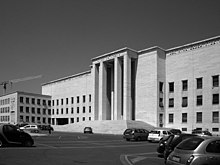Styles Littorio
Stile Littorio (Italian for lictorian style ) describes an architectural trend in fascist Italy in the 1930s.

history
The Littorio style describes an architectural language developed in Italy in the 1930s , which primarily characterizes a large number of the public buildings commissioned by the fascist regime from the beginning of the 1930s until the end of its rule. The development of the Littorio style is closely related to the development of a fascist architectural policy in which, through the direct and indirect influence of fascist institutions up to Mussolini himself, a formally exemplary, overemphasized and dogmatic, ultimately monumental architectural language was to be promoted in order to achieve the size claimed for itself and to express the historical dimension of the fascist regime.
Definition
In the history of architecture, the term Stile Littorio subsumes the appearance of the buildings and urban spaces designed and built in Fascist Italy, which in “mostly rhetorical and monumental forms” refer to a simplified architecture, which in its recourse to the ancient Roman architectural heritage is entirely classical. This type of architectural design, which is characterized by the peculiarities of the connection between abstraction and the concrete historical vocabulary of forms, became a design trend as early as the 1930s after the Roman fascis (it. Fasci littori ), which were used as symbols of fascism and the fascist party , named. As an expression of a state architecture aimed at the homogenization of the architectural language currents that were virulent in Italy in the 1920s, Christine Beese speaks of an “artistic and political consensus strategy”, the Littorio style merged monumentality and classicism with rationalism and sought a uniform, nationally connoted and recognizable style in the service of an image of the fascist state that is connoted as progressive and at the same time historically great, in particular to demonstrate power through scale and volumetric simplicity.
The term was first used when Saverio Palozzi published the results of the first competition held in 1934 for the national headquarters of the National Fascist Party (PNF), known as the Palazzo del Littorio .
literature
- Joshua Arthurs: Excavating Modernity: The Roman Past in Fascist Italy. Ithaca 2012.
- Carmen M. Enss and Luigi Monzo: 'Terms and Conditions' of Interwar Architecture and Urbanism in Italy: A Tentative Glossary. In: Enss, Carmen M. and Luigi Monzo (eds.): Townscapes in Transition. Transformation and Reorganization of Italian Cities and their Architecture in the Interwar Period. Bielefeld 2019, p. 270.
- Patrick, Goode (ed.): The Oxford Companion to Architecture. 2 volumes. New York 2009, Vol. 2, pp. 872f.
- Andrew J. Manson: Rationalism and Ruins in Roma Mussoliniana: The 1934 Palazzo del Littorio Competition. New York 2015 (Dissertation, Columbia University, 2015).
- Luigi Monzo: Croci e fasci - Italian church building in the time of fascism, 1919–1945. Karlsruhe 2017 (dissertation, Karlsruhe Institute of Technology, 2017), pp. 146–154.
- F. Saverio Palozzi: Il nuovo stile littorio: I progetti per il Palazzo del Littorio e della Mostra della Rivoluzione Fascista in via dell'Impero. Milan 1936.
Individual evidence
- ↑ cf. Luigi Monzo: Croci e fasci - Italian church building in the time of fascism, 1919–1945. Karlsruhe 2017 (dissertation, Karlsruhe Institute of Technology, 2017), pp. 146–154.
- ↑ Carmen M. Enss and Luigi Monzo: 'Terms and Conditions' of Interwar Architecture and Urbanism in Italy: A Tentative Glossary. In: Enss, Carmen M. and Luigi Monzo (eds.): Townscapes in Transition. Transformation and Reorganization of Italian Cities and their Architecture in the Interwar Period. Bielefeld 2019, p. 270.
- ↑ Christine Beese: 'La Sapienza'. The Roman university town of the 1930s and its role in Italian architectural historiography. In: architectura - Journal for the History of Architecture, 2/2016, p. 195.
- ↑ cf. F. Saverio Palozzi: Il nuovo stile littorio: I progetti per il Palazzo del Littorio e della Mostra della Rivoluzione Fascista in via dell'Impero. Milan 1936, p. 189.